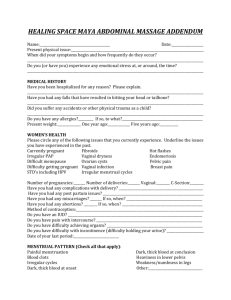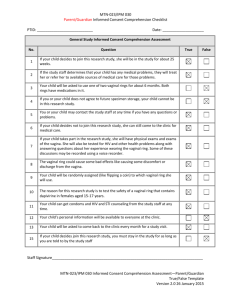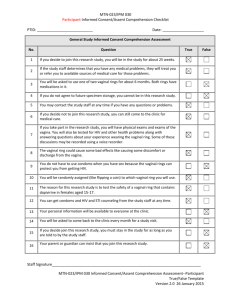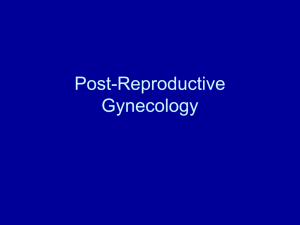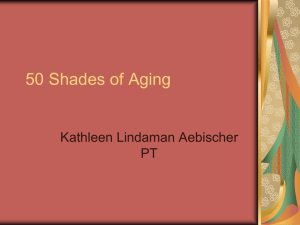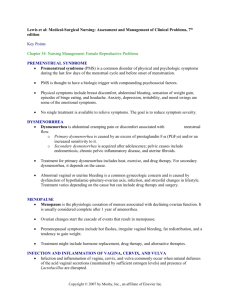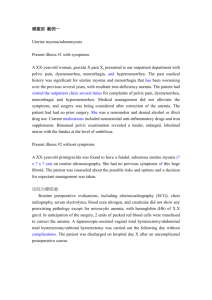Post-Reproductive Gynecology
advertisement
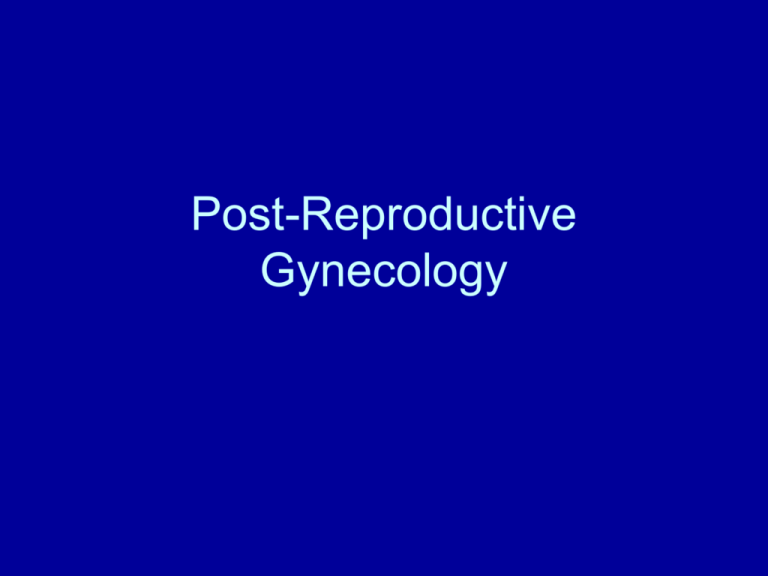
Post-Reproductive Gynecology Goals & Objectives • By the end of this lecture you will be able to: – List the reproductive system changes in postreproductive women – Describe the routine preventive care for postreproductive women – Recognize common gynecologic issues in postreproductive women with some understanding of diagnosis and treatment options – Evaluate post-reproductive woman for pelvic functional and relaxation assessment and list treatment options – Be alarmed at the changes that can occur as we age • Case Presentations Demographics • Life expectancy, 2007 – total population: 78.00 years – male: 75.20 years – female: 81.00 years • Census statistics from 2000 >06 – Total US population increasing 283 million to 299 million – Women 143 million to 151 million – Women, 40 years and older 64 million to 71 million – 43% of the total increase in our population is women over 40 Menopause & Life Expectancy 90 Age 80 70 60 50 40 30 1850 1900 1950 2000 2005 Year Age of Menopause Female Life Expectancy Objective 1 List the reproductive system changes in post-reproductive women Effects of Aging on Reproductive Physiology Symptoms of Peri-Menopause • • • • • • Hot flashes (flushes) Insomnia Vaginal dryness Mood fluctuation Depression Menstrual irregularity and eventual cessation Effects of Aging on Reproductive Organs • Vulva/Vagina – atrophy • Pelvic Support – loss of elasticity – deterioration in smooth muscle function • Cancer Risks – – – – Breast Vulvar and Vaginal Ovarian Uterine OBJECTIVE 2 – Describe the routine preventive care for post-reproductive women Preventive Gynecologic Care in Post-reproductive Women History – breast problems – vaginal or vulvar symptoms (bleeding, pain, dryness irritation, discharge) – abdominal or pelvic problems (pain, bloating) – incontinence (urinary or fecal) – domestic abuse screening – assessment of other primary care (other primary provider or just Gyn; vaccinations) Preventive Gynecologic Care in Post-reproductive Women Physical exam Vital Signs – Height/Weight/BMI, Pulse, BP, General appearance – – – – – – – – Thyroid Lymph Node survey Breasts Abdomen (mass, tenderness, hepatosplenomegaly) Vulva (attention to atrophy) Vagina/Cervix (attention to atrophy) Bimanual to assess uterus and ovaries Recto/vaginal exam Preventive Gynecologic Care in Post-reproductive Women Laboratory/Imaging Studies – Pap smear – Mammography – Lipid profile – Rectal cancer screening – Diabetes screening – Thyroid function evaluation – Consider bone density (osteoporosis) screening Preventive Gynecologic Care in Post-reproductive Women Counseling – Diet & exercise • calcium, vitamin D & folic acid – Sexuality • libido issues, vaginal dryness, sexual function issues – Menopause issues • anticipatory guidance, sleep disorders, depression OBJECTIVE 3 • Recognize common gynecologic issues in post-reproductive women with some understanding of diagnosis and treatment options Abnormal Bleeding • What do we want to know about bleeding? – Pre or post-menopausal – Cyclic vs. irregular – Location • • • • Vulvar Vaginal Cervical Uterine • Evaluation – Exam – Laboratory & Imaging • • • • Recent pap smear? Biopsy of suspicious lesions of vulva/vagina/cervix Endometrial biopsy Pelvic ultrasound Ultrasound of uterus Ultrasound of uterus ATROPHY/ATROPHIC VAGINITIS • One of most common problem Gyn visit in > 65 population • Symptoms experienced by over 40% of postmenopausal women • Presents as – – – – Dyspareunia Discharge Burning pain Urinary urgency/frequency • Caused by ? – lack of estrogen influence on urogenital tissues – resulting on loss of lubrication, thinning and decreased elasticity of vaginal mucosa Lab Diagnosis Wet mount useful to rule out other pathogens Look for high proportion of basal and parabasal cells and few if any superficial cells Vaginal pH increased (>5 when atrophy present) Atrophic Vaginitis Treatment • Most effective treatment is vaginal estrogen • 3 options for vaginal delivery – Cream • Conjugated Equine Estrogens (Premarin) • Estradiol (Estrace) – Estradiol containing ring (Estring) – Estradiol vaginal tablet (Vagifem, 25 mcg) • Minimal absorption at recommended doses • Serum Estradiol level possible to reassure patients that no systemic absorption but not necessary Treatment Options Vagifem Premarin cream Estring Lubricants “Treatment” of Menopause In the past …. – long-term (more than five years) unopposed estrogen (ET) and combined estrogen-progestin therapy (hormone therapy [HT]) routinely prescribed – For prevention • coronary heart disease (CHD) • osteoporosis – extensive observational data demonstrated protective effect of estrogen on the heart and bone Treatment of Menopause Women's Health Initiative - 2004 – Large prospective randomized controlled trial – healthy postmenopausal women ages 50 to 79 – Primarily a trial of primary prevention of cardiovascular disease – Showed increased risk of breast cancer, CHD, stroke, and venous thromboembolism with combined estrogen & progestin therapy – Showed no cardiovascular benefit with unopposed estrogen – Follow-up analyses suggest that the excess CHD risk occurs in older, but not younger postmenopausal women Hormonal Treatment of Menopause • Risks include – – – – – – coronary heart disease events stroke venous thromboembolism breast cancer breast tenderness and vaginal bleeding possible increased risk of dementia or no effect • Benefits include – reduction of fracture and colorectal cancer rise – significant decrease in hot flushes, vaginal dryness, joint pains/stiffness and general aches and pains when compared to placebo OBJECTIVE 4 • Evaluate post-reproductive woman for pelvic functional and relaxation assessment and list treatment options Pelvic Floor Relaxation • Women have 11% risk of having surgery for incontinence or prolapse symptoms by age 80 • Pelvic floor relaxation is the most common indication for hysterectomy in women over 55 • Treatment indicated for symptoms BUT • Most women with prolapse are asymptomatic Pathophysiology • The support of the pelvic floor is composed of a network of muscles, fascia and ligaments • Damage to any one of these structures may result in weakening and loss of support • Pelvic prolapse (“pelvic relaxation”) may lead to symptoms of pressure, fullness, urinary and/or fecal incontinence, need for vaginal splinting Types of Pelvic Relaxation • Cystocele and Urethrocele • Rectocele • Uterine Prolapse or Procidentia • Vaginal Vault Prolapse • Enterocele Cystocele Symptoms • Pelvic or Vaginal Pressure • Dyspareunia • Dragging or drawing vaginal sensation • Urinary Incontinence • Difficulty emptying the bladder, sometimes requiring splinting • Frequent UTI • Distension cystocele – Central defect – Note absence of rugal folds Rectocele Symptoms • Vaginal Pressure or Discomfort • Protrusion coming from the posterior wall • Constipation • Difficulty evacuating rectum (“splinting) • Dyspareunia Procidentia Total prolapse of the bladder and uterus to the outside of the body Non Surgical treatment • Pelvic Floor Rehabilitation • Pessaries – Supportive – Space occupying – Be sure to use with vaginal or systemic estrogen with postmenopausal women – Should be removed and cleaned at least every 2-4 months by patient or clinician Pessaries • Press against the walls of the vagina and are retained within the vagina by the tissues of the vaginal outlet • May cause vaginal irritation and ulceration • Are better tolerated when the vaginal epithelium is well estrogenized • Should be removed periodically, cleaned and reinserted • Failure to do so may result in serious consequences, including fistula formation • Patients may be managed successfully with a pessary for years Case Presentation 1 Chief Complaint: TDR is a 53 year old, G2P2 complaining of hot flashes, emotional difficulties, and inability to sleep History of Present Illness: 1 year hx of hot flashes occurring 2-3 times per day and occasionally at night; also having trouble sleeping for the past 6 months and is extremely fatigued. She denies any vaginal bleeding. She begins to cry in your office. Her last menstrual period was 18 months ago. Physical Exam Vital signs: 165 pounds, 5’5” 140/90 mm Hg Neck No thyromegaly, mass or lymph nodes Breast No discharge or nipple retraction No palpable masses Abdomen No masses, hernia, hepatosplenomegaly or tenderness Pelvic Normal external genitalia Vagina slightly atrophic with decreased rugae Small Cystocele (Stage 2, anterior wall descends to introitus) Uterus small and anteverted; neither ovary is palpable on bimanual exam Labs • Other routine screening tests (Pap, mammography, especially thyroid function studies – All normal • Consider complete blood count – Normal • Follicle Stimulating hormone (FSH) – Elevated • • Diagnosis: Menopause Management Plan: 1. Educate regarding normal menopause symptoms, expectations and natural history of the course of symptoms 2. Encourage good self care-taking (enough sleep and exercise, stress reduction techniques like meditation, yoga, self-help groups) 3. Discuss non-hormonal management dietary phyto-estrogens like soy Black Cohosh for depression 4. Discus hormonal medical options Case Presentation 2 Chief Complaint: EMJ is a 72-year-old woman G4P4 presents complaining of “fullness” in the vaginal area. History of Present Illness: The symptom is more noticeable when she is standing for a long period of time. She does not complain of urinary or fecal incontinence. She has no other urinary or gastrointestinal symptoms. There has been no vaginal bleeding. Her past medical history is significant for well-controlled hypertension and chronic bronchitis. She has never had surgery. Physical Exam & Labs • Neck, breast and abdominal exam normal • Pelvic exam – normal appearing external genitalia except for generalized atrophic changes – vagina and cervix are without lesions – second-degree Cystocele and Rectocele are noted – cervix descends to introitus with the patient in an erect position – no rectal masses noted with rectal sphincter tone slightly decreased – uterus is normal size; right and left ovaries are not palpable • Labs or Studies: – urinalysis and post-void residual – No evidence of UTI and post void residual normal at 35 cc. • • Diagnosis: Pelvic organ prolapse Management: 1. 2. • Educate patient regarding findings with some information on natural history and risks and complications with observation only Discuss options for management, both non-surgical and surgical Plan: 1. 2. Patient prefers non-surgical option Pessary placed and vaginal estrogen used to address atrophic changes
